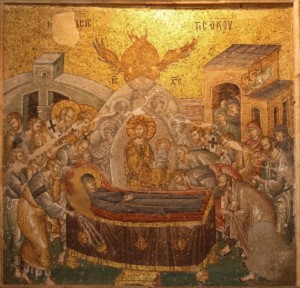Mother of Life

In the Dismissal Hymn for the Feast of the Dormition of the Theotokos, we chant the following about the Theotokos: “You were transported to life, as you are the Mother of Life.” At one level, this reflects on the events of the Dormition. Three days prior to her repose the Archangel Gabriel informed the Theotokos that she would fall asleep, and that she would be taken to Heaven to be with her Son, our Lord and Saviour Jesus Christ.
The Apostles were called from all parts of the world to farewell her and participate in her funeral. The one exception was Thomas, who was taken to the tomb of the Theotokos at Gethsemane three days after, and met her as she ascended. When the tomb was opened, all who had kept continuous vigil found it empty. Her body joined her soul, both being transported to life.
At another level “transported to life” reflects on the life and virtue of the Theotokos as the Mother of Christ. With the exception of the consequences of ancestral sin, the Theotokos was completely without sin. Her purity and her chastity throughout her life were so great that death was not able to contain her. Reflecting on the Feast of the Dormition, St John of Damascus consistently connects the Theotokos with life. She gave life to Christ, who created the universe and said, “I am the Way, the Truth and the Life” (John 14:6). In being “transported to life” the Theotokos was taken before anyone else to be with her Son in eternal life. In that way, the Theotokos is an example for the spiritual life of all Orthodox Christians.
To quote Fr Alexander Schmemann, “Mary’s not the great exception. She’s the great example.” Death cannot contain anyone who works at attaining purity, chastity and humility, who flees from sin in all of its forms, and who cultivates a deep love for God. St Andrew of Crete states that the Theotokos led the way for humanity to achieve incorruptibility, and it is time for the faithful to follow that path towards life. But how is this to be done?
St John of Damascus begs his listeners to flee from sin by describing the revulsion the Theotokos has for evil, and the great love she has for virtue. The way for us to “make our own remembrance of her into a rich monument” is to adopt purity as a way of life, as she did. It should also be remembered that the Theotokos’ role as the Mother of Life is not confined to her earthly life. It continues to this day and will continue eternally. The tomb of the Theotokos at Gethsemane is itself a place of life, with many miracles and healings occurring there. The many ongoing miracles of the Theotokos and her intercessions to Christ also show how she wishes for all of humanity to have life alongside her.
Let us then pray to the Theotokos, seeking her guidance and intercessions at all times so that we too may acquire the live-giving virtues that she showed us throughout her earthly life, and continues to show us through her intercessions and miracles.
Source: Lychnos August/September 2021
